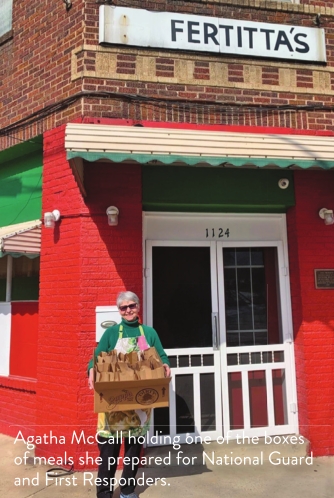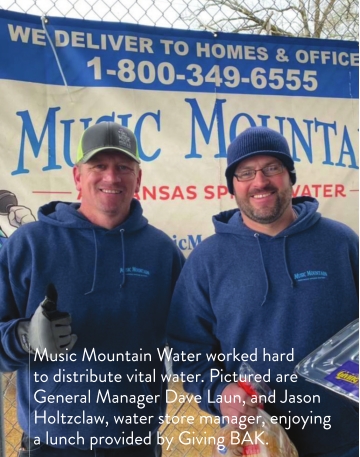Cold Warriors

Winter storm brings warm response from community, volunteers
Just when the ArkLaTex thought it was leaving the miasma of 2020 behind, Mother Nature delivered a one-two punch that tested the mettle of the entire area.
Readings of 70 to 80 degrees warmed the region while temperatures in the negative teens in the northern Plains and upper Midwest were beginning to prowl southward. Beginning Feb. 10, temperatures got cooler each day, dropping below freezing on Feb. 13, staying there until Feb. 18 or 19 in some areas.
The first indication of what was to come consisted of two minor freezing drizzle events on Feb. 12 and 13. Bridges were iced: sections of highways closed. Then during the early hours of Sunday, Feb. 14 (Valentine’s Day), Mother Nature delivered the first of two blows: snow, sleet and freezing rain. Temperatures plummeted. Tyler, Longview and Shreveport posted record lows. Shreveport’s 1-degree Fahrenheit broke a record over 100 years old. The results were widespread water main and pipe bursts across the region.
Punch two arrived during the evening of Feb. 16, hammering the region with heavy snow, cold temperatures and dangerous sleet and icing. Locations in southwest Arkansas and northeast Texas reported as much as 18-22 inches of snow, and most of the area averaged at least four inches of snow, sleet and ice covering surfaces. Extensive power outages resulted.
Natives marveled at the beauty of nature’s display while suffering at the hands of her onslaught.
The big rigs that pump the vital supplies of food and other products through the nation’s highway bloodstream were frozen in their tracks. Major arteries slowed, then stopped completely. Truckers were suddenly stranded in the elements among residents who were just as stranded in homes without power or running water.
Amidst the cold, a rising tide of determination emerged. At the Pilot station on I-10 at Fillmore, stranded truckers were fed by volunteers. The Shreveport Volunteer Network cleared roadways and delivered food and water to those in need. Private citizens used their own vehicles to help rescue stranded motorists, while others volunteered to take health-care workers to their jobs.
There are a million stories in the frozen cities; you probably have a few of your own. Municipalities and employers were faced with challenges few imagined would ever happen this far south.
The largest health-care system in the region faced not only the inconvenience, but the lifethreatening consequences. Brian Crawford is the executive senior VP and CAO of Willis Knighton Health System (WKHS).
“The majority of the challenges that were brought on by the winter storm event were two-fold. One was transportation related, in trying to provide ways for employees – those essential, critical, health-care providers – to catastrophic event. And the second was the loss of water.”
The imposition of a boil advisory in both Shreveport and Bossier City had a critical impact on the hospitals. Crawford said the hospitals maintain sufficient quantities of potable water allowing them to continue with some patient therapies, hygiene, cooking and the like. But the broken pipes in the systems led to decreasing or non-existent water pressure, which was a critical problem. So the hospitals set up a meeting between their administrators, the mayor’s office and water officials to address the issue.
Crawford said by Tuesday, Feb. 16, lack of get to work and to get home during such a water pressure forced the cancellation of all non-emergency procedures. All clinics were closed, and out-patient chemo-dialysis was closed.
“Dialysis was our biggest emergency issue,” Crawford said. “Hemodialysis patients require dialysis three days a week; each dialysis patient takes 500 gallons of water. It’s about a three- or four-hour process. This keeps them alive.”
 Crawford
said there are approximately 2,500 dialysis patients in the region, far
higher than the number local hospitals alone can treat. Many depend on
free-standing dialysis units, but those were without water as well. So,
administrators turned to the Louisiana Department of Health and the
governor’s office for assistance.
Crawford
said there are approximately 2,500 dialysis patients in the region, far
higher than the number local hospitals alone can treat. Many depend on
free-standing dialysis units, but those were without water as well. So,
administrators turned to the Louisiana Department of Health and the
governor’s office for assistance.
“The governor’s office and LDH were very responsive to our requests for water,” Crawford noted. “They immediately set up a structure with the National Guard to supply each health-care system in northwest Louisiana. We had a tanker up here within 24 hours. The non-potable was just as important because that is what we use for our heating and cooling system.”
He explained that temperatures in diagnostic areas need to be cool to protect equipment, and common areas need to be warm for patient comfort.
The situation remained critical until the water systems began to come back on-line and hospitals and free-standing clinics could resume services. Officials had two-a-day conference calls with state officials. “That’s how critical an issue the dialysis was,” Crawford said.
The concurrent critical issue of getting necessary doctors, nurses and support staff in place was equally complex. At WKHS alone, Crawford said, “we had hundreds of healthcare workers that needed to be transported to one of our five facilities.”
He said an all-call went out to the media for help since the system could not possibly transport all the needed personnel. “The response was incredible. It was overwhelming. At the end of the day we had almost 300 volunteers.”
What they called the Willis-Knighton 4 x 4 Army was made up of fire and police, volunteers from the general population, the Committee of 100, the Chamber of Commerce, the Rotary Club and other organizations.
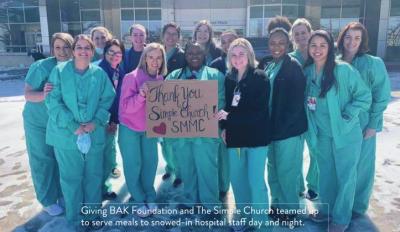
“Sheriff Steve Prator and the Caddo Parish Sheriff’s Office and Caddo’s Emergency Management Agency were outstanding in their support of our operations during this challenging event.” Crawford said.
Tommy Giles is co-founder of the Shreveport Volunteer Network. His group was one of the ones who stepped up. “We organized a bunch of four-wheel drives to take doctors and nurses to work. Cleared ice off Willis-Knighton South’s ER ramps and the streets so they could get in there.” They also worked to clear other roadways, including a bridge on Bert Kouns. “There were about 400 trucks, tractor-trailers, on the south side of the bridge because a truck had jacknifed up there on the ice. We got our machines and went up there and cleared off the ice and then pushed that 85,000-pound truck over the bridge.”
While transportation was at a virtual standstill, the flow of food was as well. Once again, local citizens and groups stood up, among them Lauren and Derrick Simmons of C&C Electric and Mercantile. They were waterless and stuck at home when they got the idea to feed people in need out of their store on Texas Avenue.
“It started at 500 meals, was our plan,” Lauren Simmons said. “Then it just kind of blew up on social media, and we ended up feeding, after the five days, we served 4,000 meals. We delivered to some assisted living homes. Delivered to some apartment complexes. To some private residences. We even delivered to a senior living home just to the staff of 25 because they had not left for a few days.
“We ended up partnering with Shreveport Police because they were distributing water to the area. So they were taking water as we were taking food: it was kind of a joint effort.”
The food came from several sources, she said – Louisiana Seafood, Parish Taceaux, Fatty Arbuckle’s and Fats Oyster House, and the small army of volunteers from Giving BAK.
Bryan Roppolo’s insulation business shares space with his disaster relief nonprofit, Giving BAK. “We go and feed people and first responders after a disaster,” he said, noting that he got a call from C&C Mercantile, then another, and he started preparing meals. “We ended up feeding right around 10,000 meals.”
The meals went to almost every hospital in the area, he explained, several residential facilities. “It ended up turning into 1,500 meals the first day. The next day, they got another thousand, the next day they got like 600. Then we ended doing like 300 meals a day for four days.
“The Fairmont Apartments downtown was without water and power. We took food to that facility and fed them for a couple of days. [C&C] partnered with the police department, and the police department brought water. So, we fed all the first responders and fire stations all week, too.”
C&C Mercantile’s Simmons praised Ropollo and his team. “Brian is a machine. He is awesome. He has a little team, I say a little team, but they’re big, burly men. They came in with cases of food and said, ‘Lemme know what you need.’ He’s just that kind of guy.”
Simmons added that her home was without water for eight days, and some area volunteers saw their neighbors’ needs. “Some people called the Saints of Highland were delivering water to people from sunup to sundown that either didn’t have running water or didn’t have drinking water, which I think was the majority of Highland.”
The Southfield girls’ softball team showed up at the Giving BAK kitchen and helped cook meals for three or four hours, Roppolo said.
All around town, friends and neighbors left whatever protection from Mother Nature they enjoyed to help those less fortunate or in trouble. Brian Crawford found the events inspirational.
“Times like these separate those in your organization and those in your community who will stand up and do the right thing.
“This event, more than anything else I’ve seen recently, tells us everything that’s right with our community. It showed we’re more alike than we are different. We all care about one another. We have each other’s backs in times of emergencies and crisis.
“I think we need to remember that in times of non-emergencies and non-crisis. We are a community. We are a big family. We should have each other’s backs.”

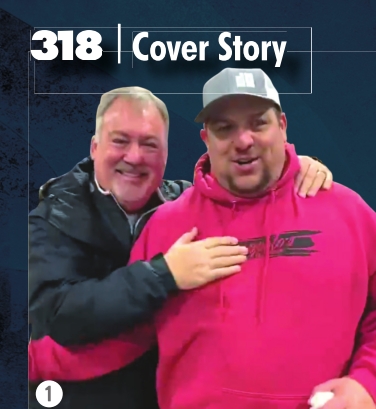
1. Care Pastor at The Simple Church Bryan Reed and Giving BAK’s Bryan Ropollo.
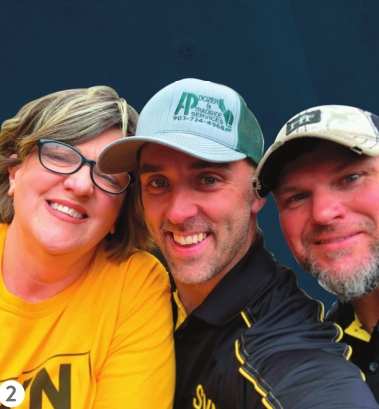
2. Rhonda Moore, City of Shreveport, and Tommy Giles and Keith Bryant, founders of the Shreveport Volunteer Network.
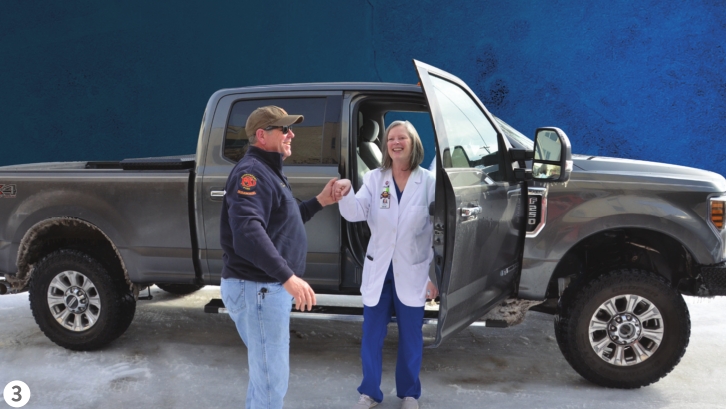
3. Shreveport Fire Department Capt. Brian Barker transporting nurses.
